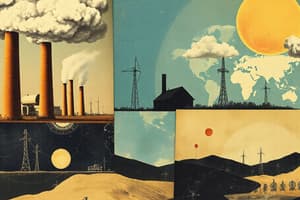Podcast
Questions and Answers
What geological era are we currently living in?
What geological era are we currently living in?
- Mesozoic
- Pleistocene
- Anthropocene (correct)
- Holocene
What is a significant factor contributing to environmental problems according to the content?
What is a significant factor contributing to environmental problems according to the content?
- Sustainable land use
- Social costs imposed on third parties (correct)
- Technological advancements
- Private costs of economic activities
Which international conference marked the first major global focus on environmental issues?
Which international conference marked the first major global focus on environmental issues?
- Rio Earth Summit 1992
- United Nations Conference on the Environment 1972 (correct)
- Kyoto Protocol 1997
- Johannesburg Summit 2002
What has the end of World War II signified regarding environmental impact?
What has the end of World War II signified regarding environmental impact?
How thick is the human biosphere around Earth?
How thick is the human biosphere around Earth?
What percentage of the earth’s original forests, known as primary forests, still exists today?
What percentage of the earth’s original forests, known as primary forests, still exists today?
Which of the following countries has the largest share of primary forests?
Which of the following countries has the largest share of primary forests?
Which activity is NOT a primary threat to forests?
Which activity is NOT a primary threat to forests?
What is one primary effect of climate change expected to occur by 2100?
What is one primary effect of climate change expected to occur by 2100?
What is a significant consequence of deforestation as mentioned?
What is a significant consequence of deforestation as mentioned?
Which of the following regions is expected to experience increased precipitation?
Which of the following regions is expected to experience increased precipitation?
How do forests contribute to combating climate change?
How do forests contribute to combating climate change?
What could potentially happen if a climate threshold is crossed?
What could potentially happen if a climate threshold is crossed?
What was the target reduction of greenhouse gas emissions established by the Kyoto Protocol from 1990 levels?
What was the target reduction of greenhouse gas emissions established by the Kyoto Protocol from 1990 levels?
Which of the following countries did not ratify the Kyoto Protocol, impacting its implementation?
Which of the following countries did not ratify the Kyoto Protocol, impacting its implementation?
What impact is climate change expected to have on dry regions?
What impact is climate change expected to have on dry regions?
What is one uncertain effect of climate change mentioned in the content?
What is one uncertain effect of climate change mentioned in the content?
What significant gain related to emissions was observed among countries that supported the Kyoto Protocol by 2012?
What significant gain related to emissions was observed among countries that supported the Kyoto Protocol by 2012?
What was a key limitation of the Kyoto Protocol regarding developing countries?
What was a key limitation of the Kyoto Protocol regarding developing countries?
What is expected to happen to the growing season as a result of climate change?
What is expected to happen to the growing season as a result of climate change?
Which example indicates a region at risk of flooding due to climate change?
Which example indicates a region at risk of flooding due to climate change?
What primary goal does the Paris Agreement aim to achieve regarding global temperature?
What primary goal does the Paris Agreement aim to achieve regarding global temperature?
What critical financial goal was set by the Paris Agreement to support climate action?
What critical financial goal was set by the Paris Agreement to support climate action?
What action is emphasized as necessary to combat climate change?
What action is emphasized as necessary to combat climate change?
Which of the following aspects was emphasized in the Paris Agreement for accountability?
Which of the following aspects was emphasized in the Paris Agreement for accountability?
What was one of the challenges associated with achieving the goals set forth by the Paris Agreement?
What was one of the challenges associated with achieving the goals set forth by the Paris Agreement?
What did Nicolas Stern advocate for regarding action on climate change?
What did Nicolas Stern advocate for regarding action on climate change?
What was a key aspect of the debate between Stern and Nordhaus?
What was a key aspect of the debate between Stern and Nordhaus?
What was a significant outcome of COP26 in Glasgow regarding climate change efforts?
What was a significant outcome of COP26 in Glasgow regarding climate change efforts?
Which model was developed by William Nordhaus to analyze climate change economics?
Which model was developed by William Nordhaus to analyze climate change economics?
Which economist is known for advocating a low discount rate in climate change economic evaluations?
Which economist is known for advocating a low discount rate in climate change economic evaluations?
What is a probable misconception about the peak usage of fossil fuels based on recent climate discussions?
What is a probable misconception about the peak usage of fossil fuels based on recent climate discussions?
What is the stance of Nordhaus regarding when to take action on climate change?
What is the stance of Nordhaus regarding when to take action on climate change?
What concept is used to assess future costs and benefits in climate change evaluations?
What concept is used to assess future costs and benefits in climate change evaluations?
What percentage of the world's population had access to safely managed drinking-water services in 2020?
What percentage of the world's population had access to safely managed drinking-water services in 2020?
Which of the following regions is NOT mentioned as having significant water scarcity issues?
Which of the following regions is NOT mentioned as having significant water scarcity issues?
What was the reported number of people lacking safely managed drinking water in 2022?
What was the reported number of people lacking safely managed drinking water in 2022?
What is a primary reason for the volatility in nonfuel natural resource prices?
What is a primary reason for the volatility in nonfuel natural resource prices?
Which conflict over water is projected to have a high likelihood of occurrence?
Which conflict over water is projected to have a high likelihood of occurrence?
What strategy is adopted to reduce dependency on mineral source countries?
What strategy is adopted to reduce dependency on mineral source countries?
Which external factor is NOT mentioned as affecting mineral prices?
Which external factor is NOT mentioned as affecting mineral prices?
Which of the following statements about the global warming link to water availability is true?
Which of the following statements about the global warming link to water availability is true?
Flashcards
Climate Change
Climate Change
The long-term changes in global weather patterns due to increased greenhouse gas emissions.
Extreme Events
Extreme Events
Events like extreme heatwaves, droughts, and intense storms that are caused by climate change.
Ocean Acidification
Ocean Acidification
The process where the ocean absorbs carbon dioxide from the atmosphere, becoming more acidic.
Frost-Free Season
Frost-Free Season
Signup and view all the flashcards
Sea Level Rise
Sea Level Rise
Signup and view all the flashcards
Threshold Effect
Threshold Effect
Signup and view all the flashcards
Atlantic Heat Conveyor
Atlantic Heat Conveyor
Signup and view all the flashcards
Methane Release from Permafrost
Methane Release from Permafrost
Signup and view all the flashcards
Human Biosphere
Human Biosphere
Signup and view all the flashcards
Anthropocene
Anthropocene
Signup and view all the flashcards
Environmental Damage as an Externality
Environmental Damage as an Externality
Signup and view all the flashcards
Environmental Externalities
Environmental Externalities
Signup and view all the flashcards
UN Environmental Conferences
UN Environmental Conferences
Signup and view all the flashcards
Climate Change Mitigation
Climate Change Mitigation
Signup and view all the flashcards
Climate Change Adaptation
Climate Change Adaptation
Signup and view all the flashcards
Stern-Nordhaus Debate
Stern-Nordhaus Debate
Signup and view all the flashcards
Discount Rate
Discount Rate
Signup and view all the flashcards
Peak Fossil Fuels
Peak Fossil Fuels
Signup and view all the flashcards
DICE Model
DICE Model
Signup and view all the flashcards
COP (Conference of the Parties)
COP (Conference of the Parties)
Signup and view all the flashcards
Stern Review
Stern Review
Signup and view all the flashcards
Deforestation
Deforestation
Signup and view all the flashcards
Primary Forests
Primary Forests
Signup and view all the flashcards
Reforestation
Reforestation
Signup and view all the flashcards
Secondary Forests
Secondary Forests
Signup and view all the flashcards
Carbon Sink
Carbon Sink
Signup and view all the flashcards
Safely Managed Drinking Water
Safely Managed Drinking Water
Signup and view all the flashcards
Water Conflicts
Water Conflicts
Signup and view all the flashcards
Water Stress
Water Stress
Signup and view all the flashcards
Volatility of Mineral Prices
Volatility of Mineral Prices
Signup and view all the flashcards
Social Costs of Minerals
Social Costs of Minerals
Signup and view all the flashcards
Resource Dependence
Resource Dependence
Signup and view all the flashcards
Resource Efficiency Strategies
Resource Efficiency Strategies
Signup and view all the flashcards
Mineral Extraction
Mineral Extraction
Signup and view all the flashcards
What was the Kyoto Protocol?
What was the Kyoto Protocol?
Signup and view all the flashcards
What was a key limitation of the Kyoto Protocol?
What was a key limitation of the Kyoto Protocol?
Signup and view all the flashcards
What were the main goals and challenges of the Kyoto Protocol?
What were the main goals and challenges of the Kyoto Protocol?
Signup and view all the flashcards
What is the Paris Agreement and how is it different from the Kyoto Protocol?
What is the Paris Agreement and how is it different from the Kyoto Protocol?
Signup and view all the flashcards
What are the key goals of the Paris Agreement?
What are the key goals of the Paris Agreement?
Signup and view all the flashcards
What is the role of transparency and accountability in the Paris Agreement?
What is the role of transparency and accountability in the Paris Agreement?
Signup and view all the flashcards
What is the importance of adaptation in the Paris Agreement?
What is the importance of adaptation in the Paris Agreement?
Signup and view all the flashcards
What is the role of cities and local authorities in the Paris Agreement?
What is the role of cities and local authorities in the Paris Agreement?
Signup and view all the flashcards
Study Notes
Climate Change and the Environment
- CO2 emissions from fossil fuels increased sixfold between 1950 and 2020
- High-income countries still have large CO2 emissions but China's share has substantially increased
- Per capita CO2 emissions are high in wealthy and oil-producing nations
- CO2 remains in the atmosphere for a long time, needing consideration of cumulative emissions
- Land use change contributes to CO2 emissions, but fossil fuels are the main source
- Annual CO2 emissions began increasing with the industrial revolution, with a major rise after 1950 due to population growth and development
- Currently, China has the largest emissions, followed by the USA, then Europe
- Wealthier nations contribute disproportionately more to global emissions, compared to low-income countries
Greenhouse Gases and Climate Change
- Climate change is not new, but human-caused change is
- Past periods included ice ages and warmer interglacial periods
- Possible causes for climate change include sunspots, volcanic activity, variations in Earth's orbit, and now increased fossil fuel emissions
- Fossil fuels have a significant impact on climate change
- Global average temperatures have risen by 1.1°C since the late 19th century
- Melting ice sheets and glaciers, decreasing snow cover and sea level rise are all effects
- Future climate changes include rising temperatures, altered precipitation patterns, lengthening frost-free seasons, more intense droughts and heat waves, stronger hurricanes, and rising sea levels
- The impacts are regional, with different areas experiencing increasing precipitation, extreme dryness, and varying water stress
UN Conferences and Environmental Concerns
- The Stockholm conference in 1972 marked the first major international gathering focused on the environment
- The 1982 Nairobi conference focused on environmental conservation and global awareness related to environmental issues
- The 1992 Rio de Janeiro Earth Summit (UNCED) led to treaties on global warming, biodiversity, and desertification, as well as discussing sustainable development
- The 2002 Johannesburg World Summit on Sustainable Development emphasized environmental concerns
- The Rio+20 summit in 2012 showed a renewed commitment to sustainable development and alternatives to calculating welfare with GDP
- More recent conferences such as COP26 and COP27 continued the efforts to mitigate climate change, but with limited actual progress to meet goals
Environmental Issues
- Air pollution, notably smog, in cities like New Delhi and China, still pose significant health risks
- Airborne lead, a persistent environmental concern, remains a major hazard, especially for children
- Acid rain, driven by fossil fuel emissions, damages building, trees, and ecosystems due to increased sulfur and nitrogen oxides in the air
- Ozone depletion is a concern primarily over the poles and is directly influenced by CFC emissions, causing serious harm to the environment
- Water pollution from sewage, chemicals, and agricultural runoff is a critical problem, especially in developing countries. Water scarcity is an issue, with conflicts potentially emerging over limited resources
- Overuse of minerals, deforestation, and land degradation are significant environmental concerns
- An alarming trend is the ongoing decline of species diversity, raising concerns over the extinction levels, with some species endangered.
Environmental Politics
- Environmental politics can be emotionally charged, rooted in differing worldviews regarding human's relationship with nature
- A more exploitative view sees humans at the center of the environment, while the mutualistic worldview recognizes the need to adapt and safeguard nature
- Environmental challenges disproportionately affect lower-income communities, often seen as hurdles to economic progress and well-being
Studying That Suits You
Use AI to generate personalized quizzes and flashcards to suit your learning preferences.




